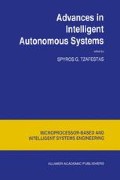Abstract
Programming of industrial robots by traditional methods results in sequential programs with predefined actions. The programs are in general interpreted by the control system and the actions described in the programs are carried out in the work-cell [12]. It is in most cases possible to attach sensors to the control system for receiving work-cell information. However, in today's industrial robotic systems sensors have limited influence on the present realization of a primitive operation. Moreover, present sensor integration does not support future use of the program in similar tasks. In practice, most problems related to sensors are connected to limited robustness in both the sensor itself and the controlling actions initiated by the controller due to sensor signals. An example of such problems is a laser triangulation sensor used for seam-tracking in arc welding operation where every weld joint with its different geometrical and optical properties need adaptations in the set-up of the sensor.
Access this chapter
Tax calculation will be finalised at checkout
Purchases are for personal use only
Preview
Unable to display preview. Download preview PDF.
References
B. Ågren. Sensor Integration for Robotic Arc Welding. PhD thesis, Department of Production and Materials Engineering, Lund University, Lund, Sweden, 1995.
R. Braun, L. Nielsen, and K. Nilsson. Reconfiguring an asea irb-6 robot system for control experiments. Technical Report TFRT-7465, Dept. of Automatic Control, Lund Institute of Technology, 1990.
K. Brink, M. Olsson, and G. Bolmsjö. Task oriented robot programming. In Proceedings of the Scandinavian Symposium on Robotics, pages 103–109, Robotics Society in Finland, October 1994.
K. Brink, M. Olsson, and G. Bolmsjö. Event based robot control, focusing on sensors. In Proceedings of the International Symposium on Measurement and Control in Robotics, Bratislava, Slovakia, June 1995.
G. Engelhard, D. Pellkofer, and K. Schuchardt. WIG-OrbitalschweiSSen. In Proceedings of DVS/SLV-München, WIG-Orbitaltechnik Conf., pages 32–40, Erding, Germany, May 1995.
Esprit Project 6042’ Hephaestos 2′. Intelligent robotic welding systems for unique fabrications. Final report, wp1, European Commission, 1994.
E. Freund and J. Rossmann. Autonomous operation of multi-robot-systems in factory of the future scenarios. 6th International Conference on CAD/CAM Robotics and Factories of the Future, 1, 1991.
G. Grunwald. Modelling and Planning for Sensor Based Intelligent Robot Systems (Task-directed planning of cooperating sensors: A framework), volume 21 of Machine Perception and Artificial Intelligence, pages 143–159. Worl Scientific, 1995.
J. L. Kolodner. Case-Based Reasoning. Morgan Kaufmann Publishers, Inc., 1993.
L-O. Larsson. The Modelling of Geometrical Parameters in Robotic GMA Welding. Department of Production and Materials Engineering, Lund University, Lund, Sweden, 1995. Licentiate thesis.
A. Naumann and P. Gu. Real time control of configurable manufacturing cells. In Proc. 10th ISPE/IFAC International Conference on CAD/CAM, Robotics, and Factories of the future, 1994.
G. Nikoleris. On the Programming of Welding Robots. PhD thesis, Department of Production and Materials Engineering, Lund University, Lund, Sweden, 1988.
K. Nilsson. Application Oriented Programming and Control of Industrial Robots. Department of Automatic Control, Lund Institute of Technology, Lund, Sweden, 2 edition, 1992. Licentiate thesis.
K. Nilsson. Industrial Robot Programming. PhD thesis, Dept. of Automatic Control, Lund Institute of Technology, 1996.
M. Olsson, K. Brink, and G. Bolmsjö. A visual task oriented robot programming system. In Proceedings of the International Symposium on Measurement and Control in Robotics, Bratislava, Slovakia, 1995.
P. C.-Y. Sheu and Q. Xue. Intelligent Robotic Planning. World Scientific Publishing, 1993.
A. Steiger-Garcao and L. M. Camarinha-Matos. A conceptual structure for a robot programming system. Robotics International Journal, 3, 1987.
Author information
Authors and Affiliations
Editor information
Editors and Affiliations
Rights and permissions
Copyright information
© 1999 Springer Science+Business Media Dordrecht
About this chapter
Cite this chapter
Bolmsjö, G., Olsson, M., Brink, K. (1999). Increased Autonomy in Industrial Robotic Systems: A Framework. In: Tzafestas, S.G. (eds) Advances in Intelligent Autonomous Systems. International Series on Microprocessor-Based and Intelligent Systems Engineering, vol 18. Springer, Dordrecht. https://doi.org/10.1007/978-94-011-4790-3_2
Download citation
DOI: https://doi.org/10.1007/978-94-011-4790-3_2
Publisher Name: Springer, Dordrecht
Print ISBN: 978-94-010-6012-7
Online ISBN: 978-94-011-4790-3
eBook Packages: Springer Book Archive

